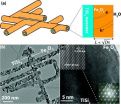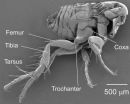(Press-News.org) CHESTNUT HILL, MA (2/9/2011) – Coating a lattice of tiny wires called Nanonets with iron oxide – known more commonly as rust – creates an economical and efficient platform for the process of water splitting, an emerging clean fuel science that harvests hydrogen from water, Boston College researchers report in the online edition of the Journal of the American Chemical Society.
Assistant Professor of Chemistry Dunwei Wang and his clean energy lab pioneered the development of Nanonets in 2008 and have since shown them to be a viable new platform for a number of energy applications by virtue of the increased surface area and improved conductivity of the nano-scale netting made from titanium disilicide, a readily available semiconductor.
Wang and his team report that coating the Nanonets with hematite, the plentiful mineral form of iron oxide, showed the mineral could absorb light efficiently and without the added expense of enhancing the material with an oxygen evolving catalyst.
The results flow directly from the introduction of the Nanonet platform, Wang said. While constructed of wires 1/400th the size of a human hair, Nanonets are highly conductive and offer significant surface area. They serve dual roles as a structural support and an efficient charge collector, allowing for maximum photon-to-charge conversion, Wang said.
"Recent research has shown that the use of a catalyst can boost the performance of hematite," said Wang. "What we have shown is the potential performance of hematite at its fundamental level, without a catalyst. By using this unique Nanonet structure, we have shed new light on the fundamental performance capabilities of hematite in water splitting."
On its own, hematite faces natural limits in its ability to transport a charge. A photon can be absorbed, but has no place to go. By giving it structure and added conductivity, the charge transport abilities of hematite increase, said Wang. Water splitting, a chemical reaction that separates water into oxygen and hydrogen gas, can be initiated by passing an electric current through water. But that process is expensive, so gains in efficiency and conductivity are required to make large-scale water splitting an economically viable source for clean energy, Wang said.
"The result highlights the importance of charge transport in semiconductor-based
water splitting, particularly for materials whose performance is limited by poor charge diffusion," the researchers report in the journal. "Our design introduces material components to provide a dedicated charge transport pathway, alleviates the reliance on the materials' intrinsic properties, and therefore has the potential to greatly broaden where and how various existing materials can be used in energy-related applications."
INFORMATION:
To view the full paper, see the Journal of the American Chemical Society website at http://pubs.acs.org/doi/full/10.1021/ja110741z.
Nanonets give rust a boost as agent in water splitting's hydrogen harvest
Nano-scale lattice developed at Boston College a promising platform for clean energy applications
2011-02-10
ELSE PRESS RELEASES FROM THIS DATE:
Key to better health care may be a walk in the park
2011-02-10
The payoff for investing in public parks and recreation sites may be healthier, more physically fit residents and a less strained healthcare system, according to Penn State researchers.
Investments in parks and recreational services have a dramatic effect on health and fitness, say Geof Godbey, professor emeritus of leisure studies, and Andrew Mowen, associate professor of recreation and parks management.
"There is a strong relationship between how much money is spent to provide such services and the amount of physical activity that people take part in," said Godbey. ...
Rice University technology in human trials to spot cardiac disease, cancer, drug abuse
2011-02-10
Heart disease is a silent killer, but new microchip technology from Rice University is expected to advance the art of diagnosis.
During National Heart Health Month, Rice Professor John McDevitt will discuss the potential of this technology to detect cardiac disease early at the annual meeting of the American Association for the Advancement of Science (AAAS) in Washington, D.C., Feb. 17-21. Cardiac disease is the focus of one of six ongoing major clinical trials of Rice's programmable bio-nano-chips (PBNCs).
PBNCs combine microfluidics, nanotechnology, advanced optics ...
Revisited human-worm relationships shed light on brain evolution
2011-02-10
"Man is but a worm" was the title of a famous caricature of Darwin's ideas in Victorian England. Now, 120 years later, a molecular analysis of mysterious marine creatures unexpectedly reveals our cousins as worms, indeed.
An international team of researchers, including a neuroscientist from the University of Florida, has produced more evidence that people have a close evolutionary connection with tiny, flatworm-like organisms scientifically known as "Acoelomorphs."
The research in the Thursday (Feb. 10) issue of Nature offers insights into brain development and human ...
A race against time to find Apollo 14's lost voyagers
2011-02-10
In communities all across the US, travelers that went to the moon and back with the Apollo 14 mission are living out their quiet lives. The voyagers in question are not astronauts. They're "moon trees."
The seeds that later became moon trees orbited the moon 34 times in the Apollo 14 command module. In this classic Apollo 14 image, taken just before the lunar module landed at Fra Mauro, Earth peeks over the edge of the moon.
In communities all across the U.S., travelers that went to the moon and back with the Apollo 14 mission are living out their quiet lives. ...
Putting trees on farms fundamental to future agricultural development
2011-02-10
Nairobi, Kenya (9 February 2011) Trees growing on farms will be essential to future development. As the number of trees in forests is declining every year, the number of trees on farms is increasing. Marking the launch of the International Year of Forest by the United Nations Forum on Forests (UNFF9) in New York on 29 January, Dennis Garrity, the Director General of the World Agroforestry Centre, highlighted the importance of mixing trees with agriculture, the practice known as agroforestry.
"Over a billion hectares of agricultural land, almost half of the world's farmland, ...
New research helps explain how progesterone prevents preterm birth
2011-02-10
SAN FRANCISCO, FEB. 10, 2011 -- Research presented today at the 31st Annual meeting of the Society for Maternal-Fetal Medicine (SMFM) ― The Pregnancy Meeting™ has found that three proteins known as XIAP, BID, and Bcl-2 are responsible in part for the success of progesterone treatments in the prevention of preterm labor. They may also play an important role in triggering normal labor.
The proteins prevent preterm birth by hindering apoptosis – the normal, orderly death of cells -- in the fetal membranes. Stronger, thicker fetal membranes are less likely to rupture ...
Use of 17-hydroxyprogesterone doesn't reduce rate of preterm delivery or complications in twins
2011-02-10
SAN FRANCISCO (February 10, 2011) — In a study to be presented today at the Society for Maternal-Fetal Medicine's (SMFM) annual meeting, The Pregnancy Meeting ™, in San Francisco, researchers will present findings that show that the use of the hormone 17-Hydroxyprogesterone does not reduce the rate of preterm delivery or neonatal complications in twins.
The hormone 17-Hydroxyprogesterone is sometimes used to reduce the risk of preterm labor. In 2008, the American College of Obstetricians and Gynecologists and the Society for Maternal-Fetal Medicine issued an opinion ...
Study finds that folate does not offer protection against preterm delivery
2011-02-10
SAN FRANCISCO (February 10, 2011) — In a study to be presented today at the Society for Maternal-Fetal Medicine's (SMFM) annual meeting, The Pregnancy Meeting ™, in San Francisco, researchers will present findings that show that folate intake before and during pregnancy does not protect Norwegian women against spontaneous preterm delivery.
"Sufficient folate intake has been studied as a possible protecting factor against spontaneous preterm delivery with conflicting results," said Verena Senpiel, M.D., one of the study's authors. "Preterm delivery is the major cause ...
Study finds magnesium sulfate may offer protection from cerebral palsy
2011-02-10
SAN FRANCISCO (February 10, 2011) — In a study to be presented today at the Society for Maternal-Fetal Medicine's (SMFM) annual meeting, The Pregnancy Meeting ™, in San Francisco, researchers will present findings that showed that in rats, the use of magnesium sulfate (Mg) significantly reduced the neonatal brain injury associated with maternal inflammation or maternal infection.
Magnesium sulfate is sometimes used during preterm labor to reduce the risk of neonatal brain injury. In 2010 the American College of Obstetricians and Gynecologists and the Society for Maternal-Fetal ...
44-year-old mystery of how fleas jump resolved
2011-02-10
If you thought that we know everything about how the flea jumps, think again. In 1967, Henry Bennet-Clark discovered that fleas store the energy needed to catapult themselves into the air in an elastic pad made of resilin. However, in the intervening years debate raged about exactly how fleas harness this explosive energy. Bennet-Clark and Miriam Rothschild came up with competing hypotheses, but neither had access to the high speed recording equipment that could resolve the problem. Turn the clock forward to Malcolm Burrows' Cambridge lab in 2010. 'We were always very puzzled ...
LAST 30 PRESS RELEASES:
Why nail-biting, procrastination and other self-sabotaging behaviors are rooted in survival instincts
Regional variations in mechanical properties of porcine leptomeninges
Artificial empathy in therapy and healthcare: advancements in interpersonal interaction technologies
Why some brains switch gears more efficiently than others
UVA’s Jundong Li wins ICDM’S 2025 Tao Li Award for data mining, machine learning
UVA’s low-power, high-performance computer power player Mircea Stan earns National Academy of Inventors fellowship
Not playing by the rules: USU researcher explores filamentous algae dynamics in rivers
Do our body clocks influence our risk of dementia?
Anthropologists offer new evidence of bipedalism in long-debated fossil discovery
Safer receipt paper from wood
Dosage-sensitive genes suggest no whole-genome duplications in ancestral angiosperm
First ancient human herpesvirus genomes document their deep history with humans
Why Some Bacteria Survive Antibiotics and How to Stop Them - New study reveals that bacteria can survive antibiotic treatment through two fundamentally different “shutdown modes”
UCLA study links scar healing to dangerous placenta condition
CHANGE-seq-BE finds off-target changes in the genome from base editors
The Journal of Nuclear Medicine Ahead-of-Print Tip Sheet: January 2, 2026
Delayed or absent first dose of measles, mumps, and rubella vaccination
Trends in US preterm birth rates by household income and race and ethnicity
Study identifies potential biomarker linked to progression and brain inflammation in multiple sclerosis
Many mothers in Norway do not show up for postnatal check-ups
Researchers want to find out why quick clay is so unstable
Superradiant spins show teamwork at the quantum scale
Cleveland Clinic Research links tumor bacteria to immunotherapy resistance in head and neck cancer
First Editorial of 2026: Resisting AI slop
Joint ground- and space-based observations reveal Saturn-mass rogue planet
Inheritable genetic variant offers protection against blood cancer risk and progression
Pigs settled Pacific islands alongside early human voyagers
A Coral reef’s daily pulse reshapes microbes in surrounding waters
EAST Tokamak experiments exceed plasma density limit, offering new approach to fusion ignition
Groundbreaking discovery reveals Africa’s oldest cremation pyre and complex ritual practices
[Press-News.org] Nanonets give rust a boost as agent in water splitting's hydrogen harvestNano-scale lattice developed at Boston College a promising platform for clean energy applications


